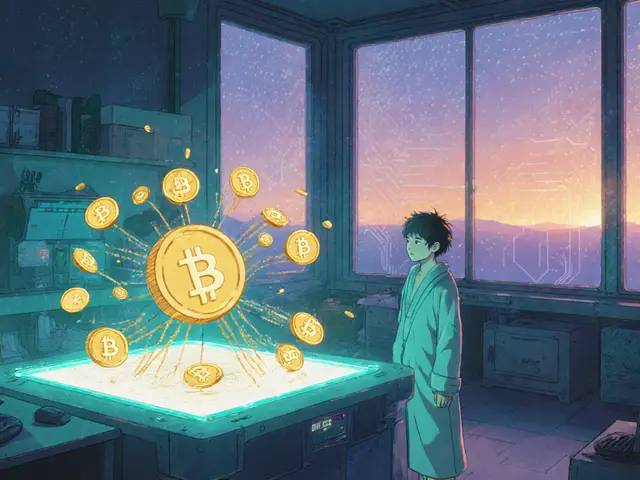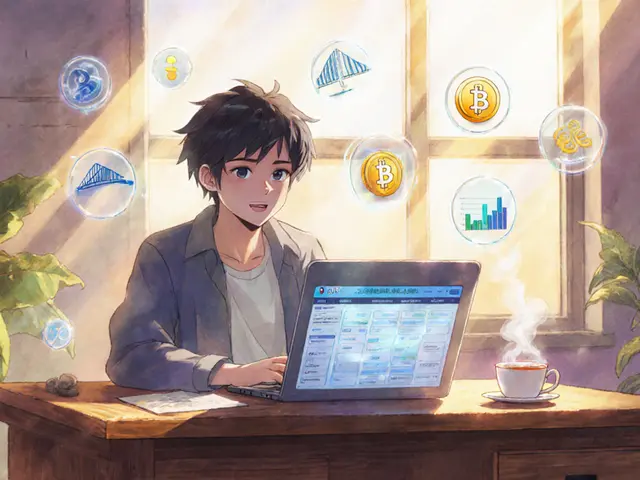DePIN ROI Calculator
Calculate Your Potential ROI
Estimate your return on investment when contributing hardware to DePIN networks based on current market conditions.
Results
Imagine a world where anyone can rent out their Wi-Fi router to create a global internet network, or turn their idle GPU into a cloud computing node that powers AI models for strangers. That’s the promise of DePIN networks - Decentralized Physical Infrastructure Networks. Instead of relying on Amazon, AT&T, or Google to build and manage physical infrastructure, DePIN lets everyday people contribute hardware and get paid in crypto. Sounds revolutionary? It is. But it’s also incredibly hard to make work at scale.
Getting the First Users and Providers to Show Up
Every DePIN project starts with a chicken-and-egg problem. Who shows up first: the person with a spare router to share, or the person who needs cheap internet? Without enough providers, users have nothing to connect to. Without enough users, providers have no reason to plug in their gear. This isn’t just a startup hurdle - it’s a structural flaw in how DePIN works.
Take Filecoin, which lets people rent out unused hard drive space. Early on, storage providers needed to buy expensive servers, wait months for demand to grow, and hope the token price held up. Many burned out. On the flip side, users didn’t trust a decentralized network to store their photos when Dropbox offered simplicity and reliability. The same problem exists with Helium’s wireless hotspots - you need enough hotspots in your neighborhood to get good coverage, but no one wants to buy one if no one else is using the network nearby.
Unlike digital-only services (like Ethereum nodes), DePIN requires real-world hardware. You can’t spin up a virtual machine in seconds. You have to buy a device, install it, power it, and keep it running. That’s a big commitment. And if your city has 10,000 people but only 30 hotspots? The network is useless. That’s why some DePIN projects now pay early adopters in cash, not just tokens, just to get the first critical mass.
The Token Economy Is Breaking Under Its Own Weight
DePIN networks pay providers with tokens - crypto coins tied to the network. The idea is simple: reward people for contributing resources. But in practice, it’s a minefield.
Token prices swing wildly. If your token drops 70% in a month, you’re not making money - you’re losing money on electricity and hardware depreciation. Providers start pulling their gear offline. Meanwhile, users see service prices spike as the token rises, making the network unaffordable.
Worse, most DePIN projects don’t have real revenue yet. They’re paying out tokens they mint themselves - essentially printing money to attract users. That’s fine for a while, but it’s not sustainable. When token inflation outpaces real demand, the whole system collapses. Look at the early days of Chia Network: they promised farmers high rewards for unused hard drive space. Then the token crashed, and most farmers quit. The network lost 80% of its storage capacity in six months.
True sustainability means users pay in real value - dollars, euros, stablecoins - and that value flows back to providers. But most DePIN projects still rely on token speculation to fund operations. That’s not a business model. It’s a Ponzi waiting to happen.
Who Fixes the Broken Router?
When your home Wi-Fi dies, you call your ISP. They send a technician. Simple.
When your DePIN-powered hotspot stops working? You’re on your own. There’s no customer support line. No warranty. No replacement device. You have to figure out if it’s a power issue, a firmware bug, or a network misconfiguration. Most users don’t have the technical skills. And even if they do, there’s no guarantee the next provider will have better hardware.
DePIN networks try to solve this with reputation systems - ratings, reviews, staking penalties. But reputation doesn’t fix a broken antenna. It doesn’t replace a dying battery. It doesn’t stop someone from plugging in a $20 Chinese hotspot that overheats and catches fire.
Centralized companies enforce quality because they’re liable. DePIN networks rely on incentives. But incentives don’t guarantee reliability. They just encourage people to stay online. And that’s not enough when you’re trying to build infrastructure people depend on - like internet access in rural areas or real-time computing for autonomous vehicles.

Blockchain Is Too Slow for Real-Time Infrastructure
DePIN networks use blockchain to record who contributed what, and how much they should be paid. That’s great for transparency. But terrible for speed.
Imagine a DePIN network that lets you rent computing power to run a video game server. You request 100 milliseconds of processing time. The blockchain needs to verify your payment, match you with a provider, confirm the provider’s uptime, and log the transaction. Even on the fastest blockchains, that takes 5-15 seconds. That’s 50 to 150 times too slow.
Real-time services - wireless handoffs between hotspots, drone navigation, live AI inference - can’t wait for blockchain confirmations. That’s why most DePIN networks use off-chain coordination: they track usage locally and settle payments on-chain only once a day. But that breaks the promise of decentralization. If you’re relying on a central server to manage usage logs, you’re just outsourcing control to a private company.
Some projects are experimenting with layer-2 solutions or sidechains. But those add complexity. And complexity kills adoption. The simpler the system, the more likely it is to work. Right now, blockchain is a bottleneck, not a breakthrough, for most physical infrastructure use cases.
Regulators Don’t Know What to Do With DePIN
Who regulates a network of strangers selling internet access from their living rooms? The FCC? The FTC? The SEC? No one knows.
DePIN networks operate in legal gray zones. If you’re running a hotspot that provides internet to others, are you a telecom provider? If so, you need licenses, security audits, and compliance with data retention laws. If you’re selling computing power, are you running an unlicensed data center? What if someone uses your GPU to mine crypto illegally? Are you liable?
In the EU, the Digital Operational Resilience Act (DORA) could classify DePIN nodes as critical infrastructure. In the U.S., the FCC has already warned that unlicensed wireless networks could interfere with emergency bands. In Brazil, tax authorities are starting to track crypto payments from DePIN providers as taxable income.
Without clear rules, investors won’t fund large-scale deployments. Governments won’t partner with DePIN projects. And users won’t trust them with sensitive data. Until regulators step in with clear frameworks - not bans, not overreach, but actual guidance - DePIN will stay stuck in niche markets.
No One Owns the Standards
There are over 50 DePIN projects today. Each one uses different hardware, different token models, different software. Some use Ethereum. Others use Solana. Some require custom ASICs. Others work with off-the-shelf routers.
There’s no universal standard for how a DePIN hotspot should communicate. No common API for accessing storage. No shared protocol for verifying that a GPU is actually working. That means you can’t move your hardware from one network to another. If Helium shuts down, your hotspot becomes a paperweight. If Render’s token crashes, your GPU sits idle.
Compare that to Wi-Fi. There’s one standard - IEEE 802.11. Every router, phone, and laptop speaks the same language. That’s why Wi-Fi works everywhere. DePIN doesn’t have that. And without interoperability, each network stays isolated. Fragmentation kills scalability.

Who Pays for the Hardware?
Building a DePIN network means buying hardware. Lots of it. A single Helium hotspot costs $200-$500. A high-end GPU for Render costs $1,500. A mining rig for AI compute can run $10,000.
Who pays? Individuals. Not corporations. Not governments. Regular people with savings and credit cards. That’s a problem.
Most people can’t afford to risk $2,000 on hardware that might become obsolete in 18 months. Or that might be seized by regulators. Or that might be hacked. Or that might not earn enough to cover electricity. The people who do invest are often crypto speculators, not infrastructure builders. They care more about token gains than network health.
That’s why DePIN networks are dominated by a small group of well-funded operators - the opposite of decentralization. The dream was to empower individuals. The reality? It’s creating a new class of crypto miners with expensive rigs.
Energy Use Is Getting Scrutiny
Every DePIN network runs on electricity. The hardware runs 24/7. The blockchain records every transaction. The more nodes, the more power.
Helium’s network uses about 1.2 gigawatt-hours per year - enough to power 100,000 homes. Render’s GPU network consumes even more. When you combine that with Ethereum’s proof-of-stake (which is better than proof-of-work, but still uses energy), the environmental cost adds up.
Green investors are starting to ask questions. Cities are passing laws to limit energy use by crypto hardware. The EU’s Crypto-Asset Regulation (MiCA) now requires disclosures on energy consumption. DePIN networks that can’t prove they’re efficient will be shut out of key markets.
Some projects are switching to low-power chips, solar-powered hotspots, or off-peak computing. But those are band-aids. The real solution? Use less blockchain. Do more computation off-chain. And accept that not everything needs to be decentralized.
DePIN Isn’t Dead - It’s Just Growing Up
DePIN networks aren’t failing. They’re evolving. The early hype was unrealistic. People thought blockchain alone could replace Google and Verizon. It can’t.
The winners will be the projects that admit the limits of decentralization. They’ll use blockchain for payments and audit trails - not for real-time control. They’ll partner with local ISPs, governments, and hardware makers. They’ll pay providers in stablecoins, not volatile tokens. They’ll build simple, reliable hardware that anyone can plug in and forget.
DePIN’s future isn’t about replacing the old world. It’s about filling the gaps - rural internet, edge computing in developing countries, open-source AI infrastructure. It’s about giving people control over the tools they use. But only if they stop pretending blockchain is magic. It’s not. It’s a tool. And like any tool, it only works when used the right way.







Write a comment
Your email address will be restricted to us